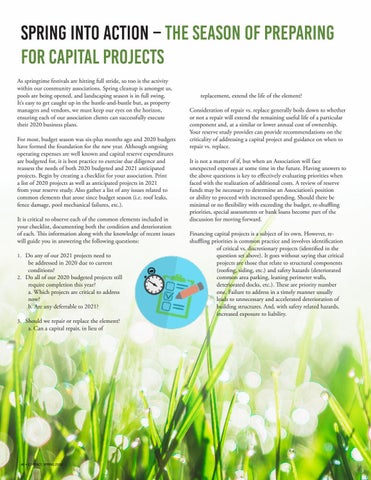As springtime festivals are hitting full stride, so too is the activity within our community associations. Spring cleanup is amongst us, pools are being opened, and landscaping season is in full swing. It’s easy to get caught up in the hustle-and-bustle but, as property managers and vendors, we must keep our eyes on the horizon, ensuring each of our association clients can successfully execute their 2020 business plans. For most, budget season was six-plus months ago and 2020 budgets have formed the foundation for the new year. Although ongoing operating expenses are well known and capital reserve expenditures are budgeted for, it is best practice to exercise due diligence and reassess the needs of both 2020 budgeted and 2021 anticipated projects. Begin by creating a checklist for your association. Print a list of 2020 projects as well as anticipated projects in 2021 from your reserve study. Also gather a list of any issues related to common elements that arose since budget season (i.e. roof leaks, fence damage, pool mechanical failures, etc.). It is critical to observe each of the common elements included in your checklist, documenting both the condition and deterioration of each. This information along with the knowledge of recent issues will guide you in answering the following questions: 1. Do any of our 2021 projects need to
be addressed in 2020 due to current conditions? 2. Do all of our 2020 budgeted projects still require completion this year? a. Which projects are critical to address now? b. Are any deferrable to 2021? 3. Should we repair or replace the element?
a. Can a capital repair, in lieu of
32••CONTACT, CONTACT,SPRING FALL 2019 46 2020
replacement, extend the life of the element? Consideration of repair vs. replace generally boils down to whether or not a repair will extend the remaining useful life of a particular component and, at a similar or lower annual cost of ownership. Your reserve study provider can provide recommendations on the criticality of addressing a capital project and guidance on when to repair vs. replace. It is not a matter of if, but when an Association will face unexpected expenses at some time in the future. Having answers to the above questions is key to effectively evaluating priorities when faced with the realization of additional costs. A review of reserve funds may be necessary to determine an Association’s position or ability to proceed with increased spending. Should there be minimal or no flexibility with exceeding the budget, re-shuffling priorities, special assessments or bank loans become part of the discussion for moving forward. Financing capital projects is a subject of its own. However, reshuffling priorities is common practice and involves identification of critical vs. discretionary projects (identified in the question set above). It goes without saying that critical projects are those that relate to structural components (roofing, siding, etc.) and safety hazards (deteriorated common area parking, leaning perimeter walls, deteriorated docks, etc.). These are priority number one. Failure to address in a timely manner usually leads to unnecessary and accelerated deterioration of building structures. And, with safety related hazards, increased exposure to liability.











